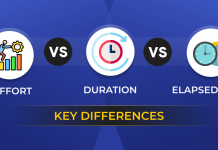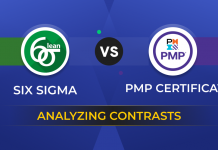
In today’s service-based environment, where everything and anything is a project, the Project Management Body of Knowledge PMBOK® has become one of the accepted standards in an organization. And this PMBoK is extensively used in various industry verticals across the globe. In a nutshell, the concepts in both PMBoK and Six Sigma Green Belt Certification have many things in common. Both try and establish a robust project plan, create communication logistics, regular reviews of the project, and manage schedule, cost, and resources.
Six Sigma is not Just Another Process Improvement Program:
Do not jump to conclusion that Six Sigma is just another project management initiative or process improvement program taken up by your organization. It is not just a new project management concept that has been repackaged with old concepts. Six Sigma has a lot more to do with continuous improvement via processes that include cultural and statistical methodologies. Though Six Sigma complements existing project management concepts it differs in lots of ways. Both Six Sigma and a typical project management methodology attempt to reduce defects, failures, control costs, and risks, and manage schedules. Often we see the PMO promoting project management best practices in the organization by introducing policies, templates and advice, and important project management tools and performing reviews on a project-by-project basis.
Six Sigma Addresses Normal Project Management Shortcomings:
There are many instances where project management benefits have not been realized. It was not because they were not adding any value, but they were not able to measure the effectiveness of the methodology or evaluate the value added by changes made to the processes. It is here where Six Sigma offers a unique perspective. By providing a structured data-driven methodology with tools and techniques, companies can easily measure changes both before and after Six Sigma projects. Using Six Sigma in your projects, you can easily determine the baseline performance of processes and also find out the root causes of problems so that they can improve them and exceed the performance levels.
Also read the blog on Project Management Life Cycle the best practice for effective project delivery!
In Six Sigma there are no Half Measures:
Six Sigma methodology helps project managers to take their projects to new levels in discipline and commitment. Whereas in standard / traditional project management, one can do away with ad-hoc implementation. But, in Six Sigma there are no half measures, which you cannot implement in bits and pieces. Either you are completely in or not, or you are in it for the long haul and not looking at short-term benefits. Again this full-fledged approach is a good thing for your organization as the level of commitment gets everyone involved and results in a substantial change in your processes.
Six Sigma Provides Robust Tools and Techniques:
Project managers face a lot of challenges while gathering data and analyzing, problem-solving, evaluating and understanding processes and tracking measurements, and realizing benefits. Six Sigma methodology provides all the tools and techniques that are necessary for a project manager to overcome the challenges stated above. It does not replace an organization’s existing methodologies but acts as a complementary methodology that replaces existing ways of determining, resolving, and analyzing problems, as well as achieving customer and business requirements in an objective manner.
Six Sigma Overcomes Operational Management Inefficiencies:
Six Sigma can also be applied to operational management inefficiencies and can directly support strategic management development and its implementation. Six Sigma’s tools and techniques are much more broadly applicable than those commonly applied to project management. Moreover, Six Sigma and its tools are directed more towards finding the root cause of the problems and preventing them from recurrence than attempting to do damage control on each and every project.
Data Collection is Crucial to Everything in Six Sigma:
Six Sigma also differs from typical project management with regard to precision in handling business-critical processes in an organization. This robust methodology gives you a well-defined project charter that outlines the scope, benefits, and milestones of a project. Moreover, all the decisions taken will be based on proper data collection which will help in improved savings. In normal project management, an enterprise enters into it without properly knowing what will be the financial gains. But, Six Sigma has a crucial control phase (DMAIC: Define, Measure, Analyze, Improve, and Control) which helps in measuring, identifying problems, and providing specific solutions for each and every problem.
Six Sigma has made its foray into the organizational culture around the world and business-critical projects are seeing immense benefits from it. Six Sigma also includes other important methodologies in Total Quality Management (TQM), Statistical Process Control (SPC), Define, Measure, Analyze, Design, and Verify (DMADV), and more. Six Sigma offers a holistic approach to managing a project and brings a significant change in the organizational culture which brings a long-lasting change.














